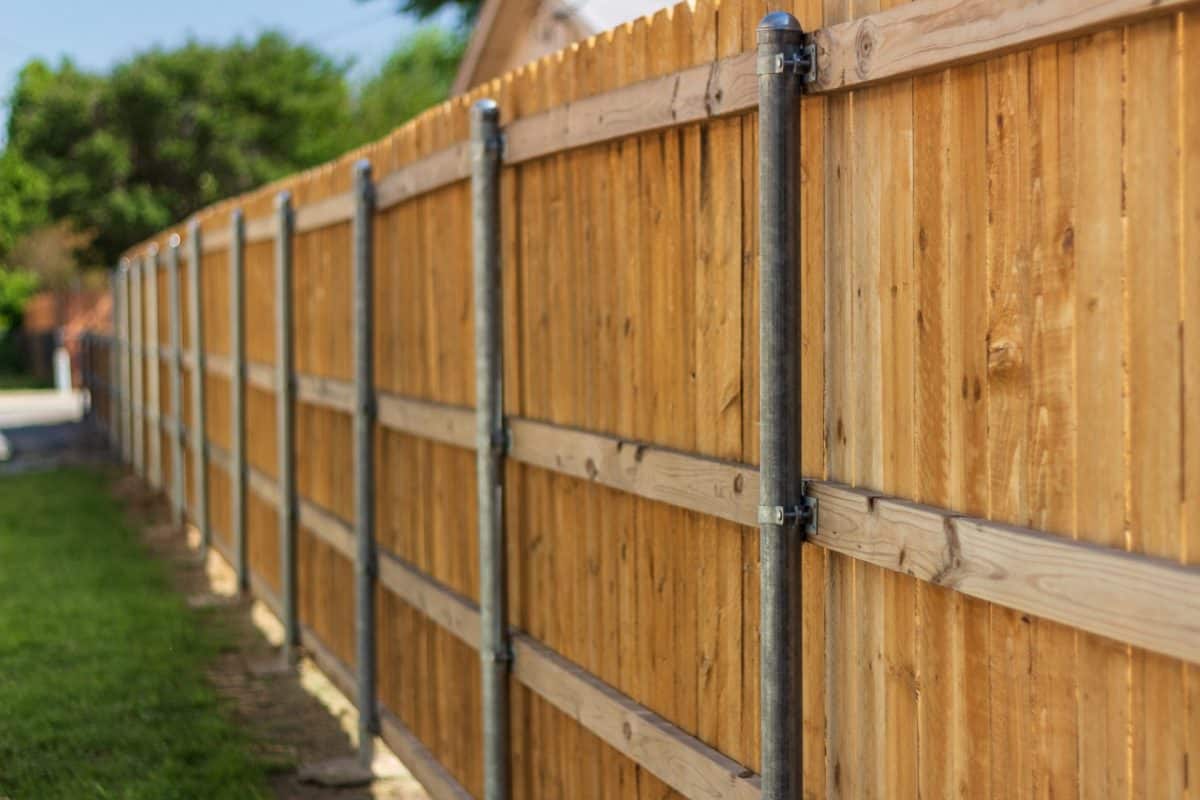Fence posts should typically be spaced about six to eight feet apart. While depth also matters, setting fence posts at this distance provides a good balance between sturdiness and cost.
When it comes to home fencing, the choice is often between prefabricated panels and custom-cut fences.
Prefabricated panels usually come in six or eight-foot widths, meaning your post spacing must be precise to accommodate these.
In fact, you generally can't set the posts in concrete until the panels are installed due to the need for precise distance measurements.

Custom-cut fences offer more flexibility. You can cut your own rails from 2x4 lumber or another material and choose your own post spacing.
This means you can adapt the spacing to suit your yard, local regulations, or personal preference.
Distance between posts by type of fence
The spacing between fence posts can vary depending on the type of fence:
- Chain-link fences are stronger, so the posts can be spaced as far apart as 10 feet.
- Wood and vinyl fences: The standard spacing for these is typically eight feet.
- Barbed wire fences, on the other hand, can have greater distances between posts.
Digging post holes is a crucial part of the fence installation process and should be done carefully to ensure the fence's stability.
How Far Apart Should Fence Posts Be?
Post spacing mainly depends on the fencing style.
Fence styles with 8-12 feet post spacing include:
- Field fence
- Horse fence
- Sheep and goat fence
- Barbed wire
- Welded wire
- Yard fence
- Garden fence
- Kennel fence
- Hog wire fence
On the other hand, deer, orchards, and wildlife fence posts are distanced 15-20 feet apart. In comparison, high tensile barbed and smooth wire fence posts are spaced 20-30 feet apart.
What Factors To Consider In Spacing Fence Post?
As mentioned, several factors affect fencing post spacing. Here are some of them:
- Fencing Material Weight
- Land Terrain
- Soil Type
- Land Use
- Fence Post Strength
Terminal posts play a crucial role in the overall strength and stability of a fence, particularly in the corners and ends of the fence line.

Terrain Slope And The Distance Between Fence Posts
The distance between fence posts might need to be adjusted when dealing with sloped or uneven ground. Here's why:
Stepped fencing
If you're using a 'stepped' approach, where each panel steps up or down to follow the slope, you may need to adjust post spacing.
This is because the slope's angle could affect each step's width and the posts' alignment.

When using the 'stepped' approach, the ground can slope away from the bottom rail, potentially leaving a gap under the fence. This might not be ideal if you're trying to keep small pets in or deter animals from entering your yard.
In such cases, you might need to set the posts closer than eight feet or consider other options, like adding filler material at the bottom or choosing a raked or contoured design.
Raked or contoured fencing
If you're using 'raked' fencing (where the fence follows the slope of the ground) or 'contoured' fencing (where the fence adjusts to the ground's contours), precise post spacing is crucial.
The angle of the fence panels must match the slope, which might mean altering the standard post distance.
Remember, the key is to maintain the strength and stability of the fence, no matter the slope. Always measure carefully, taking the ground's level into account.
Soil Type And The Distance Between Fence Posts
While soil type doesn't directly affect the distance between fence posts, it does play a critical role in their stability and depth.
In softer soils, like black soil or clay, the posts need to be driven deeper to ensure they don't move over time. In some cases, you might need to reach the rock bed underneath for proper stability.
Rocky soils, though harder to work with initially, can offer advantages. Once a post is firmly set among rocks, those rocks can provide extra support, reinforcing the stability of your fence.
Maximum Distance Between Fence Posts
The maximum distance between fence posts largely depends on the type of fence and the loads it will bear.
For most residential fences, this distance is typically between six to eight feet.

However, in some cases, like chain-link or wire boundary fences, posts can be spaced up to 10 feet or even 25 feet apart.
Always remember: Greater distances between posts can reduce your fence's overall strength and stability. Therefore, while increasing post spacing to save on materials or labor might be tempting, doing so could result in a less durable fence.
Minimum Distance Between Fence Posts
The minimum distance between fence posts is usually determined by the width of the fence pickets or panels.
However, if you're building a custom fence or dealing with a unique landscape feature or slope, you might set posts closer together than the standard panel width.
Remember, though, that while setting posts closer together can increase fence strength, it also requires more posts and potentially more labor.




